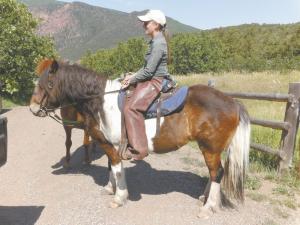2018 - Volume #42, Issue #6, Page #10
[ Sample Stories From This Issue | List of All Stories In This Issue | Print this story
| Read this issue]
Icelandic Horses Have Unique Gait
 |
Averaging 12 to 13 hands high, “They are big horses in little bodies,” according to Bayley Donahue.
Donahue exercises the Icelandics that are raised at Hanging Valley Ranch, outside of Carbondale, Colorado. She rides nearly every day, regardless of the weather, and says “They have a lot of go, with no spoiled-pony attitudes.”
Oakton Applegate, manager of the ranch, likes their consistently calm dispositions. He explains, “If you don’t ride a Quarter horse for six months, he’s going to be salty. An Icelandic stays smooth, sensible, and willing to please.”
Shortly after taking the job in 2005, Oakton traded in his own Quarter horses. A lifelong hunter, he once tested a four-year-old Icelandic by tossing a cougar carcass over its neck. “It didn’t spook at all, but just stood there,” he said.
But the most unique thing about Icelandic horses is their natural ability to gait. Besides the walk, trot and canter, they do a “tolt,” which is described as a gallop-like walk covering 20 miles an hour. It is so smooth that a rider can drink from a glass of water without spilling a drop.
Another, the “flying pace,” is a two-beat movement that’s most commonly used for short-distance racing. In the pace, both legs on one side alternate with both legs of the other, allowing the horse to reach speeds of up to 30 miles an hour.
The owners of Hanging Valley, Garry and Sharon Snook, imported three prized mares after falling in love with them in 1999. Using artificial insemination, they “mixed and matched” the mares with three prized stallions to get the finest animals. In 2015, two of their horses were judged “highest evaluated in the U.S.” Most are sold for trail, pleasure, and competition, being shipped as far away as Alaska, Kentucky, and North Carolina.
The Icelandic is one of the purest-bred horses in the world, having originated around 865 A.D. with stock that belonged to Norsemen. No other breeds have been brought into the country since then. Once an animal leaves, it cannot be brought back in, thus ensuring that pureness.
Temperatures rarely rise above 50 degrees in their native country, so Icelandic horses are well-adapted to harsh weather. They grow thick, heavy coats and long, luxurious manes and tails.
“We leave ours outside all year long, even when foaling,” Oakton said. Although there is a spacious barn on the property, “we only stall an animal if it’s being inseminated or needs special care.”
For more information go to icelandicmountainhorses.com or email oakapplegate@hotmail.com.

Click here to download page story appeared in.

Click here to read entire issue
To read the rest of this story, download this issue below or click here to register with your account number.




